Effects of Platycodins Folium on Depression in Mice Based on a UPLC-Q/TOF-MS Serum Assay and Hippocampus Metabolomics
Abstract
1. Introduction
2. Results
2.1. Effects of PF on Behavioral Evaluations
2.1.1. Effects of PF on SPT and BW
2.1.2. Effects of PF on the Immobility Time in FST
2.1.3. Effects of PF on the Immobility Time in TST
2.2. Effects of PF on Biochemical Parameters
2.3. Metabolic Profiles of LPS-induced Depression under HPF Treatment
2.3.1. Validation of UPLC-Q/TOF-MS
2.3.2. Identification of the Differential Metabolites and Metabolic Pathways
3. Discussion
3.1. Lipid Metabolism
3.2. Amino Acid Metabolism
3.3. Energy Metabolism
3.4. Other Metabolisms
4. Materials and Methods
4.1. Chemicals
4.2. Animals and Administration
4.3. Behavioral Tests
4.3.1. Sucrose Preference Test (SPT) and Body Weight (BW)
4.3.2. Forced Swimming Test (FST)
4.3.3. Tail Suspension Test (TST)
4.4. ELISA Determination
4.5. Spectrum Acquisition
4.5.1. Sample Collection and Preparation
4.5.2. UPLC-Q/TOF-MS Conditions
4.6. Data Analysis
5. Conclusions
Supplementary Materials
Author Contributions
Funding
Conflicts of Interest
References
- Du, H.L.; Zhao, H.X.; Lai, X.L.; Lin, Q.S.; Zhu, Z.Y.; Chai, Y.F.; Lou, Z.Y. Metabolic profiles revealed synergistically antidepressant effects of lilies and Rhizoma Anemarrhenae in a rat model of depression. Biomed. Chromatogr. 2016, 31, 487–493. [Google Scholar] [CrossRef] [PubMed]
- Dhingra, D.; Bhankher, A. Behavioral and biochemical evidences for antidepressant-like activity of palmatine in mice subjected to chronic unpredictable mild stress. Pharmacol. Rep. 2014, 66, 1–9. [Google Scholar] [CrossRef] [PubMed]
- Müller, N.; Myint, A.M.; Schwarz, M.J. Inflammatory biomarkers and depression. Neurotox. Res. 2011, 19, 308–318. [Google Scholar] [CrossRef] [PubMed]
- Duman, R.S.; Voleti, B. Signaling pathways underlying the pathophysiology and treatment of depression: Novel mechanisms for rapid-acting agents. Trends Neurosci. 2012, 35, 47–56. [Google Scholar] [CrossRef]
- Khurana, R.N.; Baudendistel, T.E. Hypertensive crisis associated with venlafaxine. Am. J. Med. 2003, 115, 676–677. [Google Scholar] [CrossRef]
- Desanty, K.P.; Amabile, C.M.; Amabile, C.M. Antidepressant-induced liver injury. Ann. Pharmacother. 2007, 41, 1201–1211. [Google Scholar] [CrossRef]
- Xiong, Z.L.; Yang, J.; Huang, Y.; Zhang, K.; Bo, Y.H.; Lu, X.M.; Su, G.Y.; Ma, J.; Yang, J.Y.; Zhao, L.S.; et al. Serum metabonomics study of anti-depressive effect of Xiao-Chai-Hu-Tang on rat model of chronic unpredictable mild stress. J. Chromatogr. B 2016, 1029, 28–35. [Google Scholar] [CrossRef]
- Zhang, L.; Wang, Y.L.; Yang, D.W.; Zhang, C.H.; Zhang, N.; Li, M.H.; Liu, Y.Z. Platycodon grandiflorus–An Ethnopharmacological, phytochemical and pharmacological review. J. Ethnopharmacol. 2015, 164, 147–161. [Google Scholar] [CrossRef]
- Ou, L.L.; Yu, X.; Zhu, Y.; Zhang, C. Study on anti-inflammatory activity of extracts from different parts of Platycodon grandiflorum. J. Anhui Agri. Sci. 2013, 41, 10272–10274. [Google Scholar]
- Liu, D.; Tan, W. Nutritional composition and antioxidant activities of Platycodon grandiflorum flower and leaf. Agro. Food Industry Hi Tech. 2016, 27, 44–46. [Google Scholar]
- Tian, Y.H.; Gao, G.; Liu, Y.; Li, W.; Wang, Z.; Guo, J.; Wang, Y.P. Study on anti-tumor effect and its mechanism of the saponins of Platycodon grandiflorum stem and leaf on H22 tumor-bearing mice. J. Toxicol. 2016, 30, 45–48. [Google Scholar]
- Lee, J.W.; Ji, S.H.; Kim, G.S.; Song, K.S.; Um, Y.; Kim, O.T.; Yi, L.; Chang, P.H.; Shin, D.H.; Kim, C.K.; et al. Global Profiling of Various Metabolites in Platycodon grandiflorum by UPLC-QTOF/MS. Int. J. Mol. Sci. 2015, 16, 26786–26796. [Google Scholar] [CrossRef] [PubMed]
- Wang, C.Z.; Zhang, N.Q.; Wang, Z.Z.; Qi, Z.; Zhu, H.L.; Zheng, B.Z.; Li, P.Y.; Liu, J.P. Nontargeted metabolomic analysis of four different parts of Platycodon grandiflorum grown in northeast china. Molecules 2017, 22, 1280. [Google Scholar] [CrossRef] [PubMed]
- Nicholson, J.K.; Lindon, J.C.; Holmes, E. ‘Metabonomics’: Understanding the metabolic responses of living systems to pathophysiological stimuli via multivariate statistical analysis of biological NMR spectroscopic data. Xenobiotica 1999, 29, 1181–1189. [Google Scholar] [CrossRef]
- Hood, L.; Heath, J.R.; Phelps, M.E.; Lin, B.Y. Systems biology and new technologies enable predictive and preventative medicine. Science 2004, 306, 640–643. [Google Scholar] [CrossRef] [PubMed]
- Fiehn, O.; Putri, S.P.; Saito, K.; Salek, R.M.; Creek, D.J. Metabolomics continues to expand: Highlights from the 2015 metabolomics conference. Metabolomics 2015, 11, 1036–1040. [Google Scholar] [CrossRef][Green Version]
- Wu, X.; Huang, Y.; Sun, J.H.; Wen, Y.Q.; Qin, F.; Zhao, L.S.; Xiong, Z.L. A HILIC-UHPLC-MS/MS untargeted urinary metabonomics combined with quantitative analysis of five polar biomarkers on osteoporosis rats after oral administration of Gushudan. J. Chromatogr. B 2017, 1072, 40–49. [Google Scholar] [CrossRef] [PubMed]
- Wang, W.D.; Liu, X.F.; Liu, J.P.; Cai, E.B.; Zhao, Y.; Li, H.J.; Zhang, L.X.; Li, P.Y.; Gao, Y.G. Sesquiterpenoids from the root of panax ginseng attenuates lipopolysaccharide-induced depressive-like behavior through the brain-derived neurotrophic factor/tropomyosin-related kinase b and sirtuin type 1/nuclear factor-κb signaling pathways. J. Agric. Food Chem. 2017, 66, 265–271. [Google Scholar] [CrossRef]
- Li, J.Y.; Liu, Y.; Li, W.; Wang, Z.; Guo, P.; Li, L.; Li, N.J. Metabolic profiling of the effects of ginsenoside Re in an Alzheimer’s disease mouse model. Behav. Brain Res. 2018, 337, 160–172. [Google Scholar] [CrossRef]
- Wu, Y.; Fu, Y.Y.; Rao, C.L.; Li, W.W.; Liang, Z.H.; Zhou, C.J.; Shen, P.; Cheng, P.F.; Zeng, L.; Zhu, D.; et al. Metabolomic analysis reveals metabolic disturbances in the prefrontal cortex of the lipopolysaccharide-induced mouse model of depression. Behav. Brain Res. 2016, 308, 115–127. [Google Scholar] [CrossRef]
- Li, S.J.; Lin, H.; Tang, Y.P.; Li, W.X.; Shen, J.; Kai, J.; Yue, S.J.; Shang, G.X.; Zhu, Z.H.; Shang, E.X.; et al. Comparative metabolomics analysis on invigorating blood circulation for herb pair Gui-Hong by ultra-high-performance liquid chromatography coupled to quadrupole time-of-flight mass spectrometry and pattern recognition approach. J. Pharm. Biomed. Anal. 2015, 107, 456–463. [Google Scholar] [CrossRef]
- Howren, M.B.; Lamkin, D.M.; Suls, J. Associations of depression with C-reactive protein, IL-1, and IL-6: A meta-analysis. Psychosom. Med. 2009, 71, 171–186. [Google Scholar] [CrossRef]
- Felger, J.C. The role of dopamine in inflammation-associated depression: Mechanisms and therapeutic implications. Curr. Top. Behav. Neurosci. 2016, 31, 199–219. [Google Scholar]
- Dowlati, Y.; Herrmann, N.; Swardfager, W.; Liu, H.; Sham, L.; Reim, E.K.; Lanctôt, K.L. A meta-analysis of cytokines in major depression. Biol. Psychiatry. 2010, 67, 446–457. [Google Scholar] [CrossRef]
- Bakunina, N.; Pariante, C.M.; Zunszain, P.A. Immune mechanisms linked to depression via oxidative stress and neuroprogression. Immunology 2015, 144, 365–373. [Google Scholar] [CrossRef] [PubMed]
- Wenk, M.R. Lipidomics: New tools and applications. Cell 2010, 143, 888–895. [Google Scholar] [CrossRef]
- Liu, X.Y.; Zheng, P.; Zhao, X.J.; Zhang, Y.Q.; Hu, C.X.; Li, J.; Zhao, J.Y.; Zhou, J.J.; Xie, P.; Xu, G.W. Discovery and validation of plasma biomarkers for major depressive disorder classification based on liquid chromatography-mass spectrometry. J. Proteome Res. 2015, 14, 2322–2330. [Google Scholar] [CrossRef] [PubMed]
- Pagano, R.E. What is the fate of diacylglycerol produced at the Golgi apparatus. Trends Biochem. Sci. 1988, 13, 202–205. [Google Scholar] [CrossRef]
- Chan, R.B.; Oliveira, T.G.; Cortes, E.P.; Honig, L.S.; Duff, K.E.; Small, S.A.; Wenk, M.R.; Shui, G.; Di, P.G. Comparative lipidomic analysis of mouse and human brain with alzheimer disease. J. Biol. Chem. 2012, 287, 2678–2688. [Google Scholar] [CrossRef]
- Modicanapolitano, J.S.; Renshaw, P.F. Ethanolamine and phosphoethanolamine inhibit mitochondrial function in vitro: Implications for mitochondrial dysfunction hypothesis in depression and bipolar disorder. Biol. Psychiat. 2004, 55, 273–277. [Google Scholar] [CrossRef]
- Zhang, M.L.; Wang, Y.; Zhang, Q.; Wang, C.S.; Zhang, D.W.; Wan, J.B.; Yan, C.Y. UPLC/Q-TOF-MS-based metabolomics study of the anti-osteoporosis effects of Achyranthes bidentata polysaccharides in ovariectomized rats. Int. J. Biol. Macromol. 2018, 112, 433–441. [Google Scholar] [CrossRef] [PubMed]
- Colsch, B.; Fenaille, F.; Warnet, A.; Junot, C.; Tabet, J.C. Mechanisms governing the fragmentation of glycerophospholipids containing choline and ethanolamine polar head groups. Eur. J. Mass Spectrom. 2017, 23, 427–444. [Google Scholar] [CrossRef] [PubMed]
- Ma, Z.J.; Zhang, W.; Dong, J.M.; Yu, X.H.; Zhao, X.M.; Pu, S.B. Preliminary screening of biomarkers for curcumin’s antidepressant effect based on metabonomics method. Zhongguo Zhong Yao Za Zhi 2017, 42, 3596–3601. [Google Scholar]
- Demirkan, A.; Isaacs, A.; Ugocsai, P.; Liebisch, G.; Struchalin, M.; Rudan, I.; Wilson, J.F.; Pramstaller, P.P.; Gyllensten, U.; Campbell, H.; et al. Plasma phosphatidylcholine and sphingomyelin concentrations are associated with depression and anxiety symptoms in a dutch family-based lipidomics study. J. Psychiatr. Res. 2013, 47, 357–362. [Google Scholar] [CrossRef]
- Willner, P. Validity, reliability and utility of the chronic mild stress model of depression: A 10-year review and evaluation. Psychopharmacology 1997, 134, 319–329. [Google Scholar] [CrossRef] [PubMed]
- Chang, X.; Jia, H.M.; Zhou, C.; Zhang, H.W.; Yu, M.; Yang, J.S.; Zou, Z.M. Role of Bai-Shao towards the antidepressant effect of Chaihu-Shu-Gan-San using metabonomics integrated with chemical fingerprinting. J. Chromatogr. B 2015, 1006, 16–29. [Google Scholar] [CrossRef]
- Sahlin, K.; Tonkonogi, M.; Söderlund, K. Energy supply and muscle fatigue in humans. Acta Physiol. 1998, 62, 261–266. [Google Scholar] [CrossRef]
- Sargent, M.G. Life Ascending: The Ten Great Inventions of Evolution. Interdiscip. Sci Rev. 2010, 35, 95–97. [Google Scholar]
- Nitto, T.; Onodera, K. Linkage between coenzyme a metabolism and inflammation: Roles of pantetheinase. J. Pharmacol Sci. 2013, 123, 1–8. [Google Scholar] [CrossRef]
- Jung, S.; Kim, M.K.; Choi, B.Y. The long-term relationship between dietary pantothenic acid (vitamin B5) intake and C-reactive protein concentration in adults aged 40 years and older. Nutr. Metab. Cardiovasc. Dis. 2017, 27, 806–816. [Google Scholar] [CrossRef]
- Gong, M.J.; Han, B.; Wang, S.M.; Liang, S.W.; Zou, Z.J. Icariin reverses corticosterone-induced depression-like behavior, decrease in hippocampal brain-derived neurotrophic factor (BDNF) and metabolic network disturbances revealed by NMR-based metabonomics in rats. J. Pharm. Biomed. Anal. 2016, 123, 63–73. [Google Scholar] [CrossRef]
- Li, J.J.; Lin, S.; Guo, C.H.; Yang, J.Y.; Xiao, B.K.; Huang, R.Q. Metabonomics study on antidepressant effect of banxia-houpo decoction. SciTech Eng. 2014, 28, 22–26. [Google Scholar]
- Coussens, L.M.; Werb, Z. Inflammation and cancer. Nature 2002, 420, 860–867. [Google Scholar] [CrossRef]
- Knowles, E.E.; Huynh, K.; Meikle, P.J.; Göring, H.H.; Olvera, R.L.; Mathias, S.R.; Duggirala, R.; Almasy, L.; Blangero, J.; Curran, J.E.; et al. The lipidome in major depressive disorder: Shared genetic influence for ether-phosphatidylcholines, a plasma-based phenotype related to inflammation, and disease risk. Eur. Psychiatry 2017, 43, 44–50. [Google Scholar] [CrossRef] [PubMed]
- Pearson, T.A.; Mensah, G.A.; Alexander, R.W.; Anderson, J.L.; Cannon, R.O.; Criqui, M.; Fadl, Y.Y.; Fortmann, S.P.; Hong, Y.; Myers, G.L.; et al. Markers of inflammation and cardiovascular disease application to clinical and public health practice—A statement for healthcare professionals from the centers for disease control and prevention and the American Heart Association. Circulation 2003, 107, 499–511. [Google Scholar] [CrossRef]
- Couto, N.; Malys, N.; Gaskell, S.J.; Barber, J. Partition and turnover of glutathione reductase from saccharomyces cerevisiae: A proteomic approach. J. Proteome Res. 2013, 12, 2885–2894. [Google Scholar] [CrossRef]
- Freed, R.D.; Hollenhorst, C.; Weiduschat, N.; Mao, X.; Kang, G.; Shungu, D.C.; Gabbay, V. A pilot study of cortical glutathione in youth with depression. Psychiat. Res. Neur. 2017, 270, 54–60. [Google Scholar] [CrossRef] [PubMed]
- Shimon, H.; Agam, G.; Belmaker, R.H.; Hyde, T.M.; Kleinman, J.E. Reduced frontal cortex inositol levels in postmortem brain of suicide victims and patients with bipolar disorder. Am. J. Psychiatry 1997, 154, 1148–1150. [Google Scholar]
- Levine, J. Controlled trials of inositol in psychiatry. Eur. Neuropsychopharmacol. 1997, 7, 147–155. [Google Scholar] [CrossRef]
- Mormède, C.; Palin, K.; Kelley, K.W.; Castanon, N.; Dantzer, R. Conditioned taste aversion with lipopolysaccharide and peptidoglycan does not activate cytokine gene expression in the spleen and hypothalamus of mice. Brain Behav. Immun. 2004, 18, 186–200. [Google Scholar] [CrossRef]
- Ge, W.J.; Li, H.J.; Zhao, Y.; Cai, E.B.; Zhu, H.Y.; Gao, Y.G.; Liu, S.L.; Yang, H.; Zhang, L.X. Study on antidepressant activity of sesquiterpenoids from ginseng root. J. Funct. Foods 2017, 33, 261–267. [Google Scholar] [CrossRef]
- Frenois, F.; Moreau, M.; O’connor, J.; Lawson, M.; Micon, C.; Lestage, J.; Kelley, K.W.; Dantzer, R.; Castanon, N. Lipopolysaccharide induces delayed FosB/DeltaFosB immunostaining within the mouse extended amygdala, hippocampus and hypothalamus, that parallel the expression of depressive-like behavior. Psychoneuroendocrinology 2007, 32, 516–531. [Google Scholar] [CrossRef]
- Lin, M.Z.; Li, H.J.; Zhao, Y.; Cai, E.B.; Zhu, H.Y.; Gao, Y.G.; Liu, S.L.; Yang, H.; Zhang, L.X.; Tang, G.S.; et al. Ergosteryl 2-naphthoate, an ergosterol derivative, exhibits antidepressant effects mediated by the modification of GABAergic and Glutamatergic systems. Molecules 2017, 22, 565. [Google Scholar] [CrossRef] [PubMed]
- Zhu, J.J.; Djukovic, D.; Deng, L.L.; Gu, H.W.; Himmati, F.; Abu Zaid, M.; Chiorean, E.G.; Raftery, D. Targeted serum metabolite profiling and sequential metabolite ratio analysis for colorectal cancer progression monitoring. Anal. Bioanal. Chem. 2015, 407, 7857–7863. [Google Scholar] [CrossRef]
- Zhu, J.J.; Djukovic, D.; Deng, L.L.; Gu, H.W.; Himmati, F.; Chiorean, E.G.; Raftery, D. Colorectal Cancer Detection Using Targeted Serum Metabolic Profiling. J. Proteome Res. 2014, 13, 4120–4130. [Google Scholar] [CrossRef] [PubMed]
- Zhao, Y.Y.; Cheng, X.L.; Wei, F.; Xiao, X.Y.; Sun, W.J.; Zhang, Y.; Lin, R.C. Serum metabonomics study of adenine-induced chronic renal failure in rats by ultra performance liquid chromatography coupled with quadrupole time-of-flight mass spectrometry. Biomarkers 2012, 17, 48–55. [Google Scholar] [CrossRef] [PubMed]
Sample Availability: Samples of the compounds are available from the authors. |
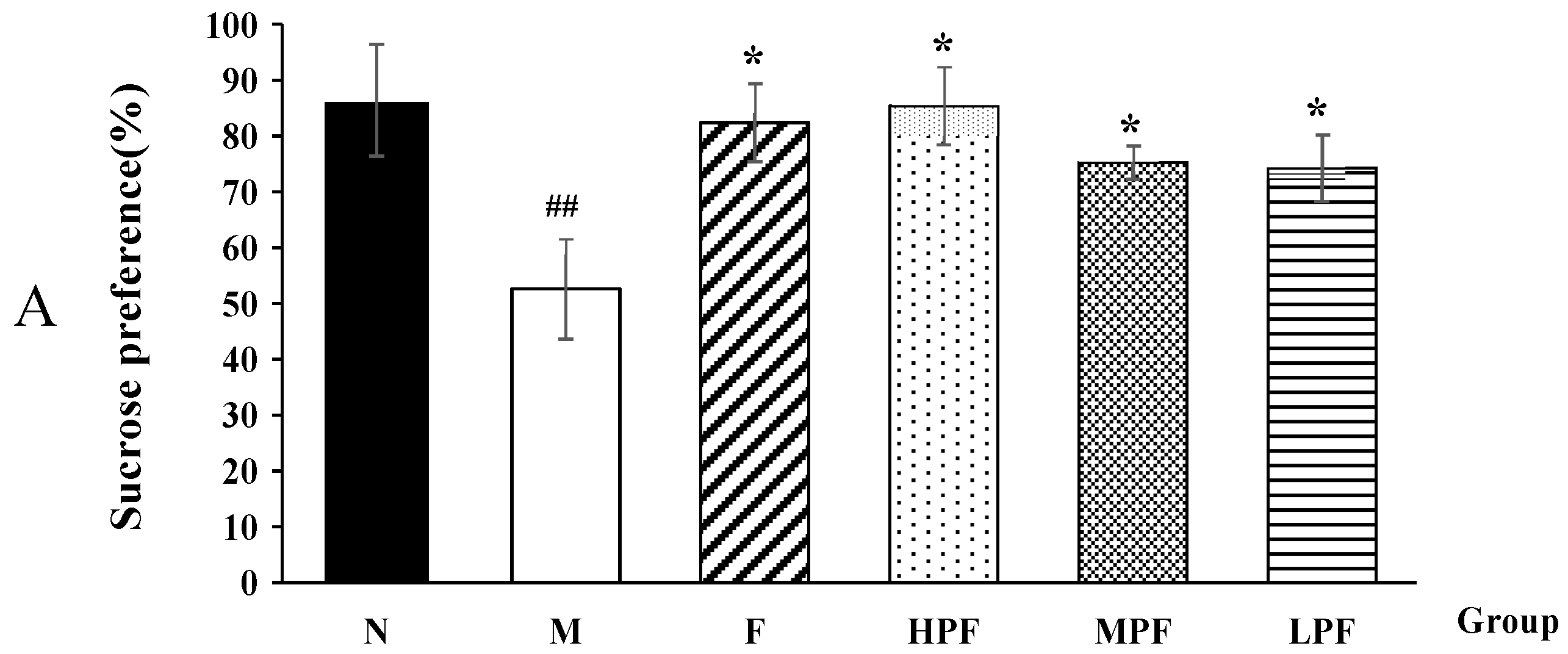
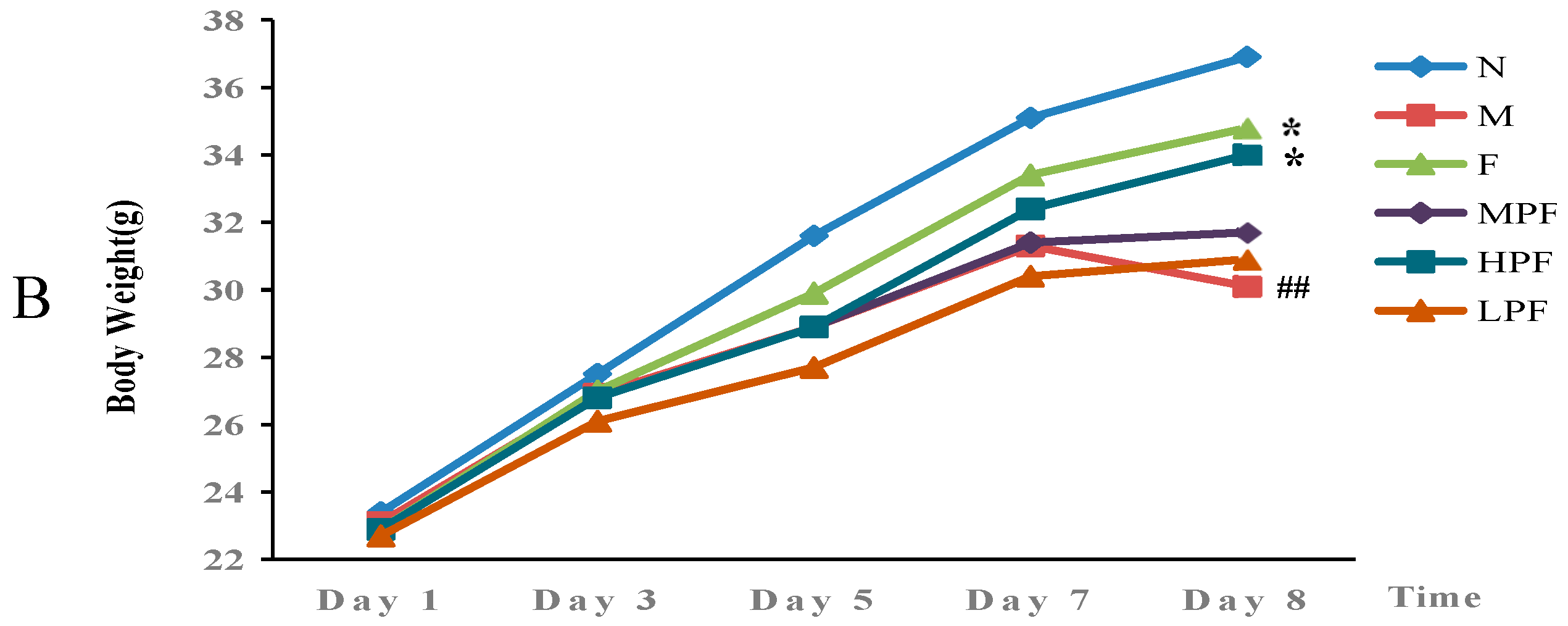
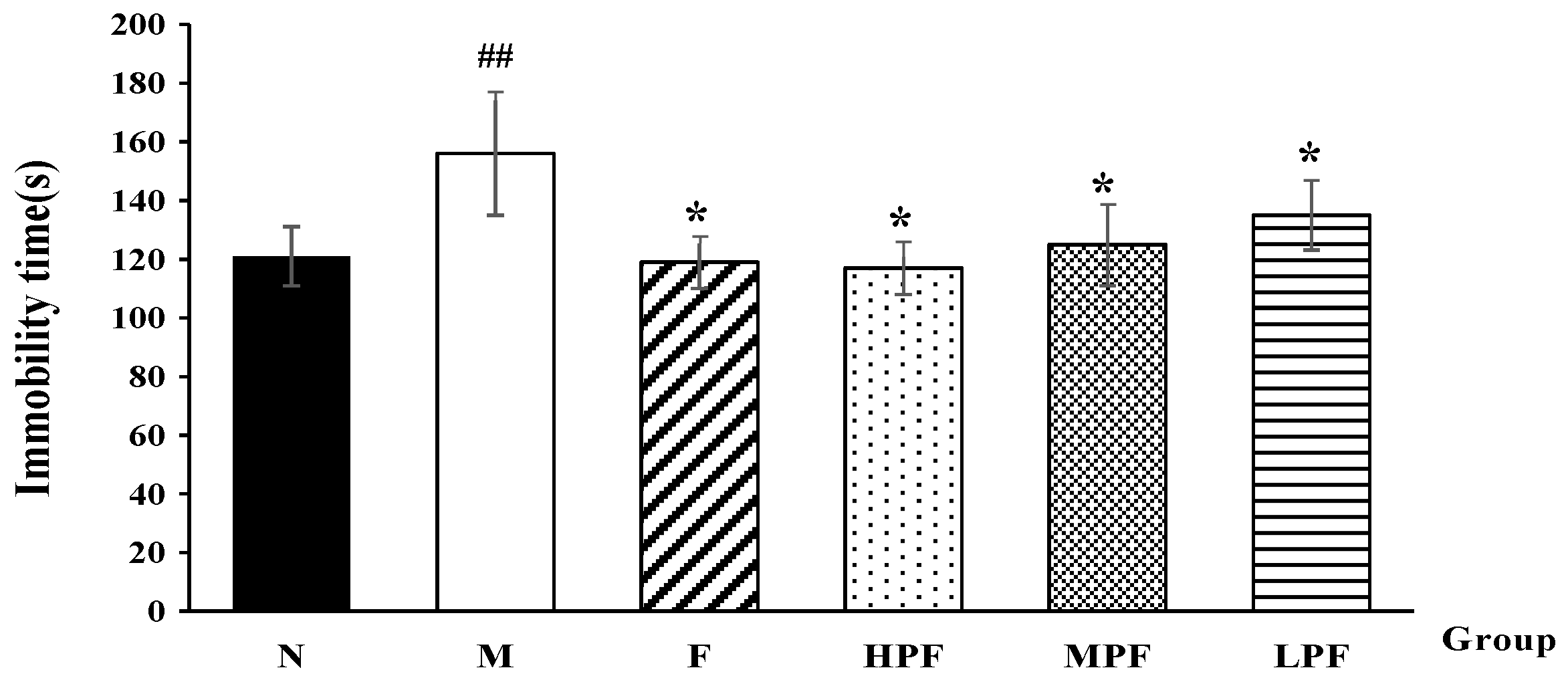
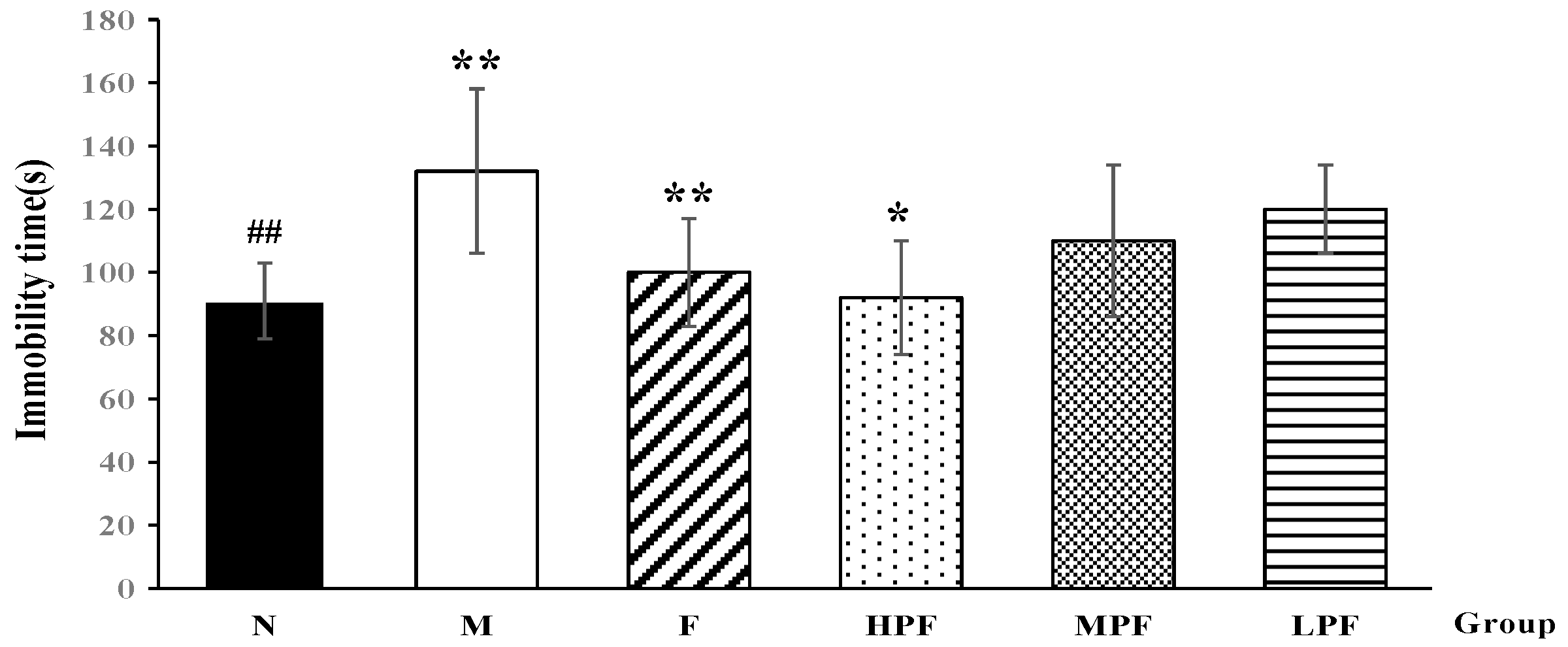
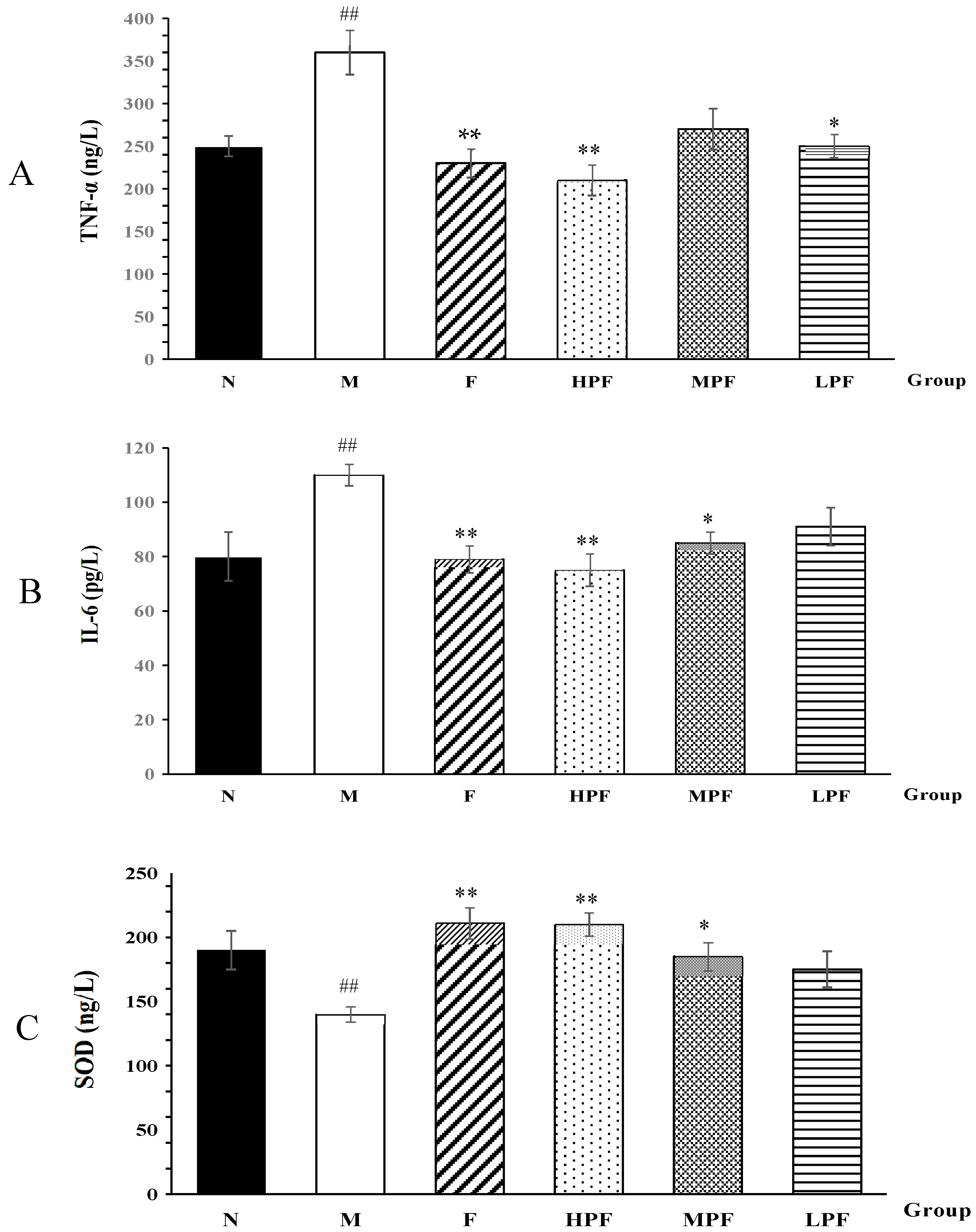
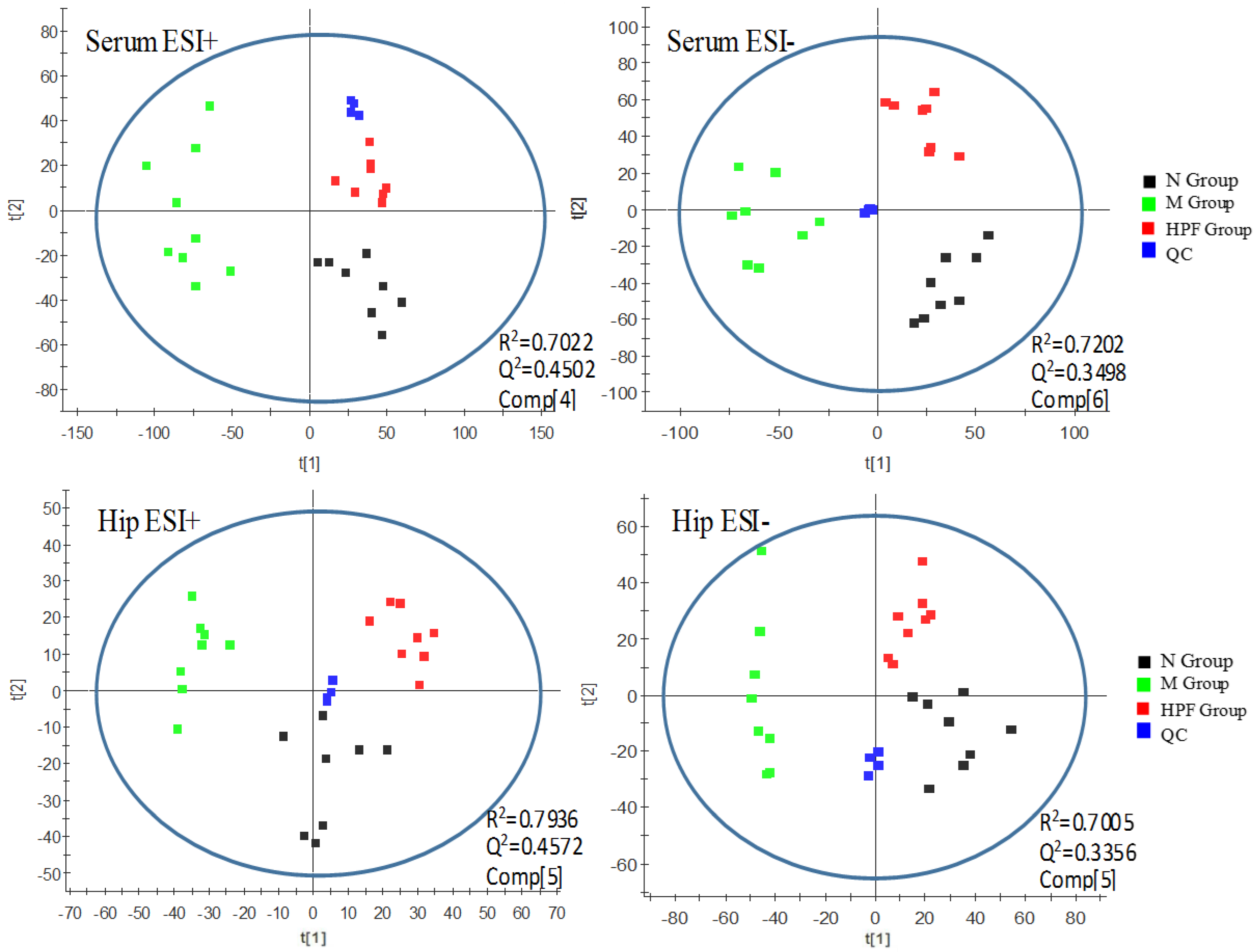

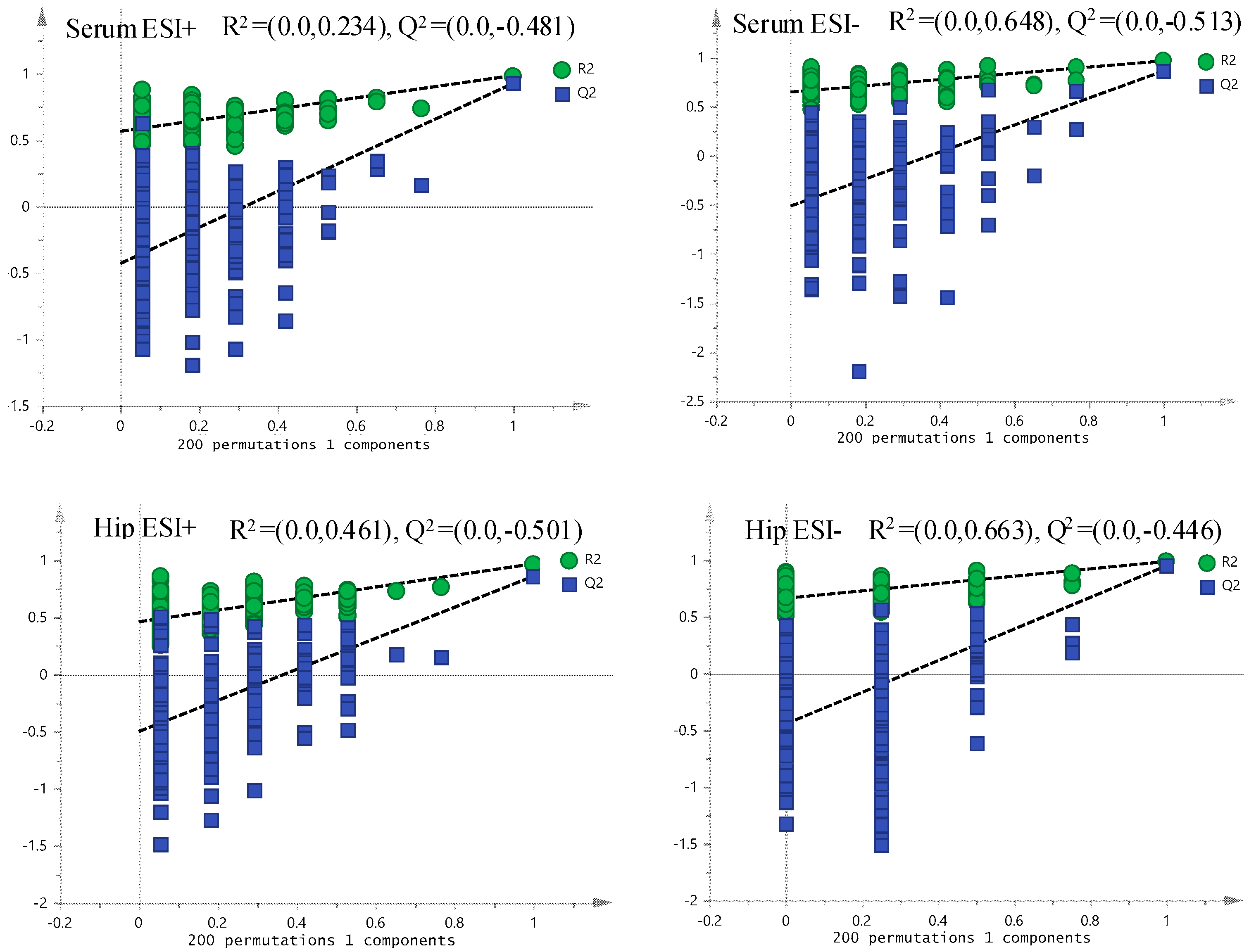
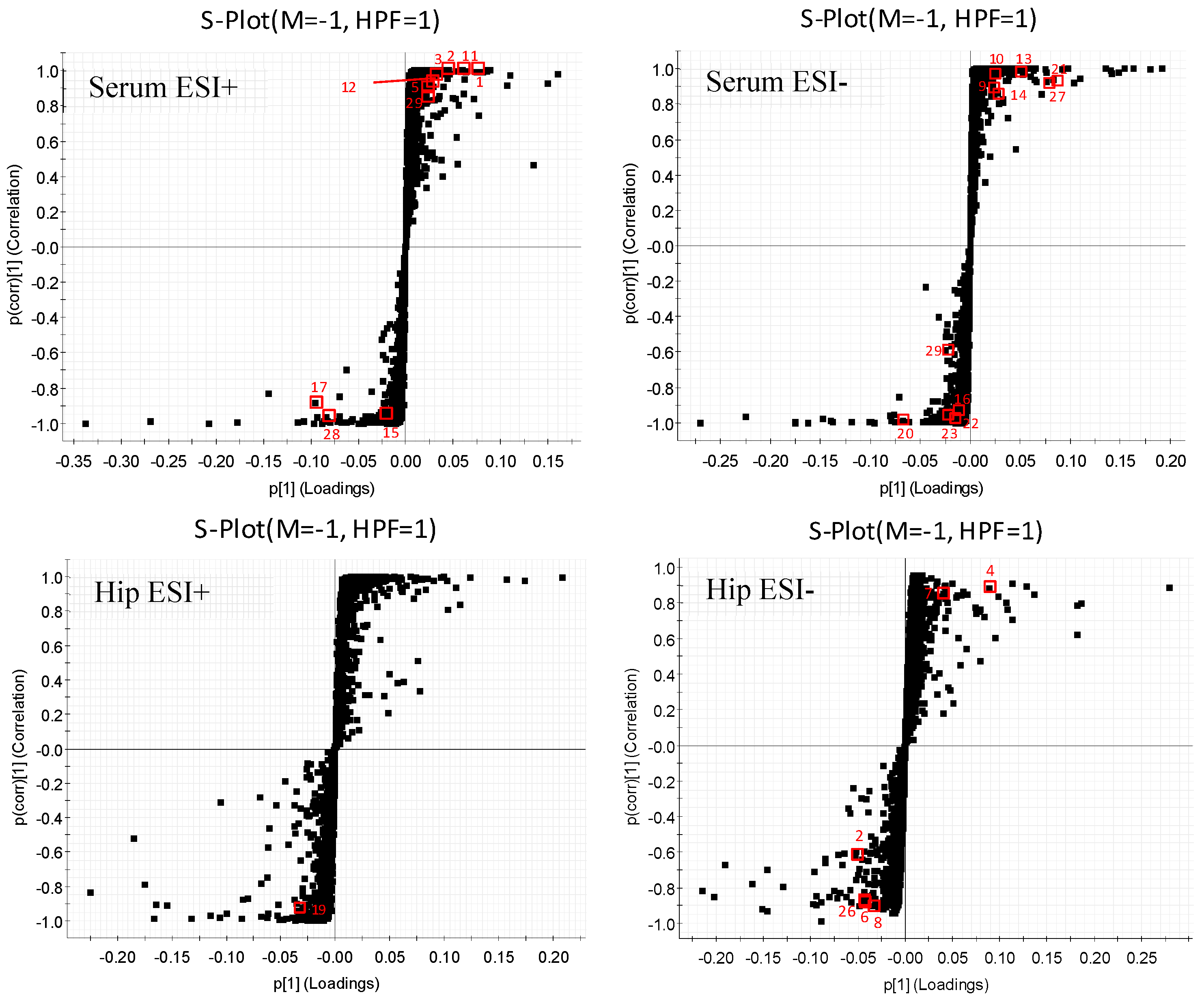

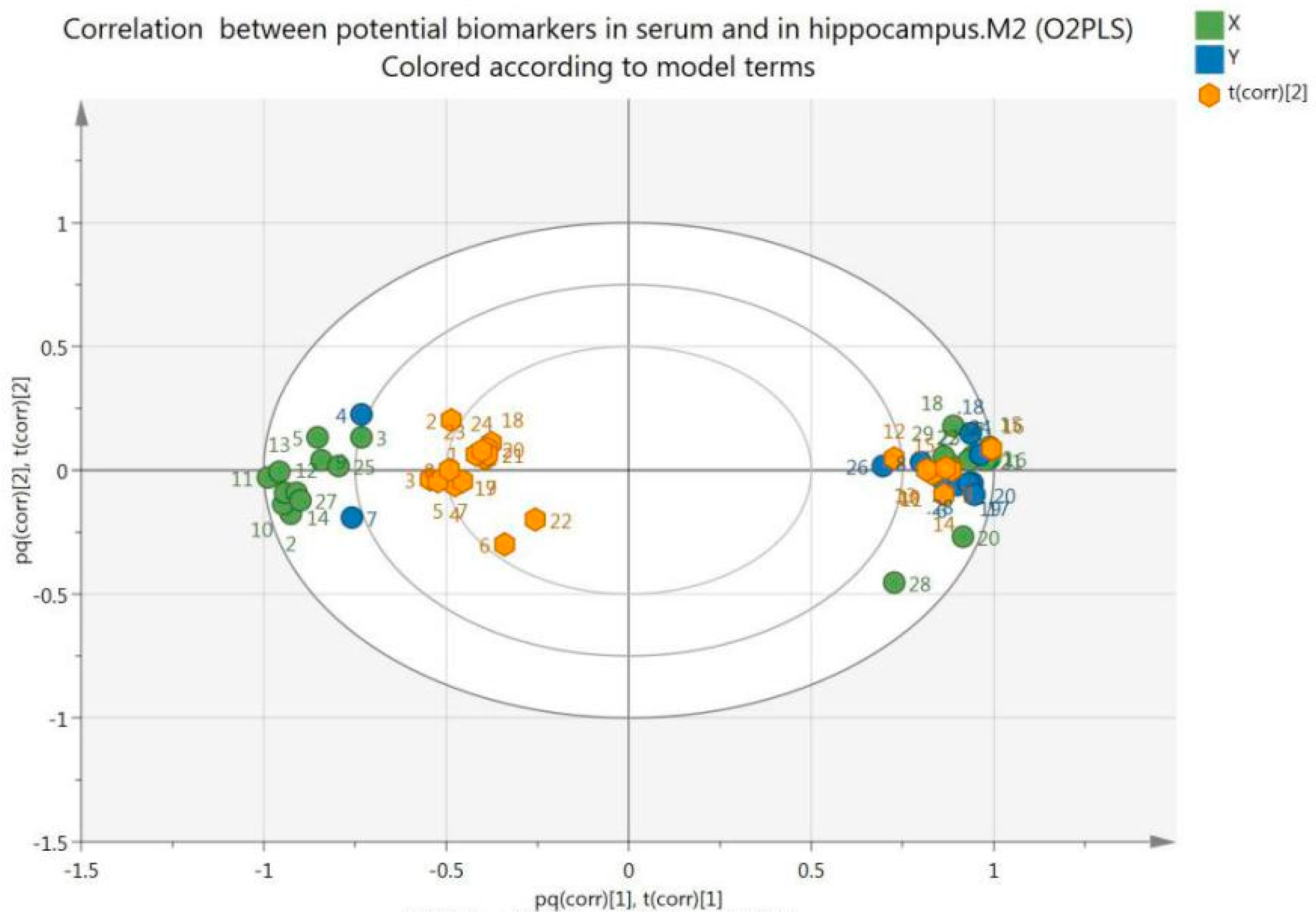
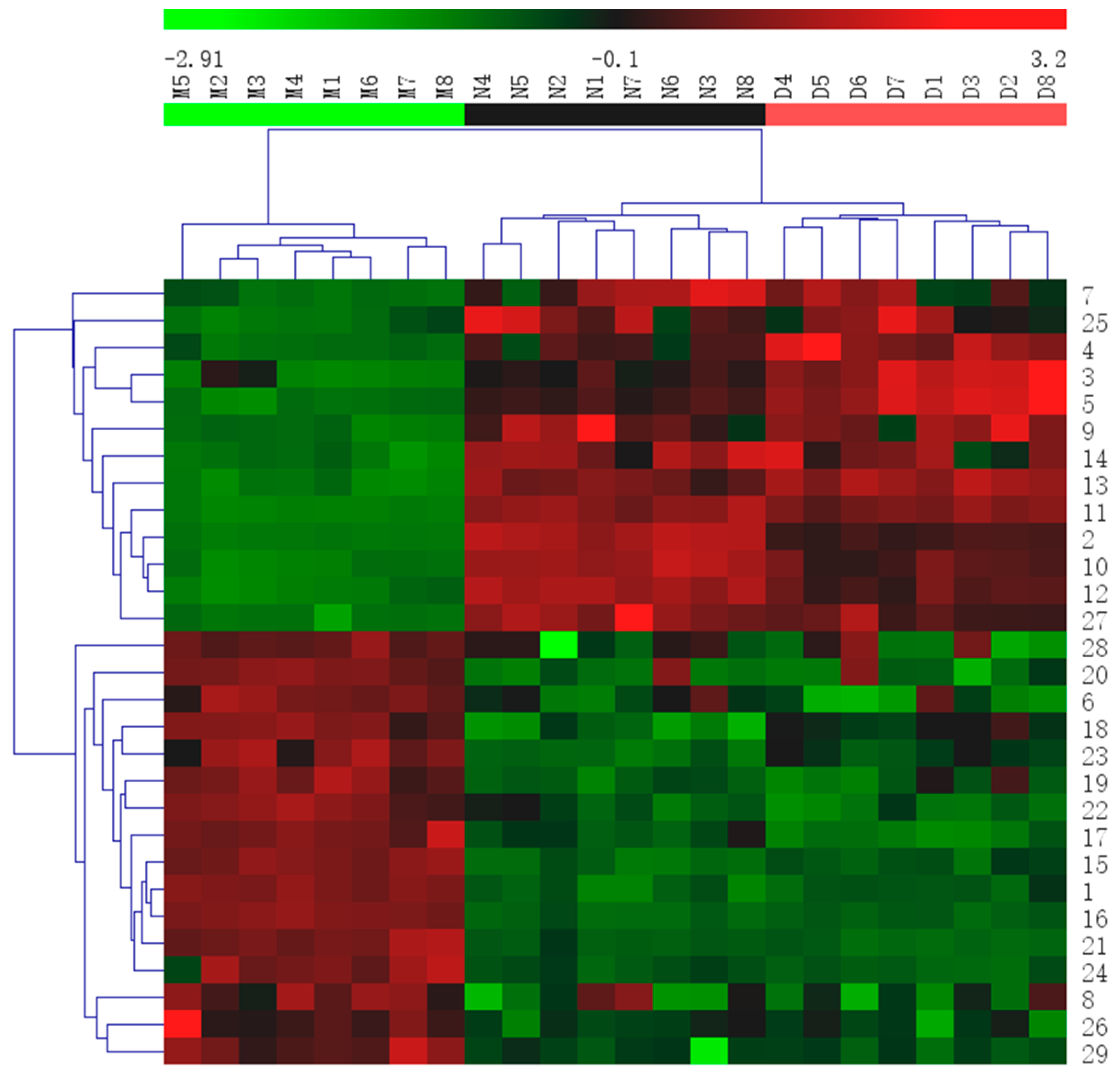
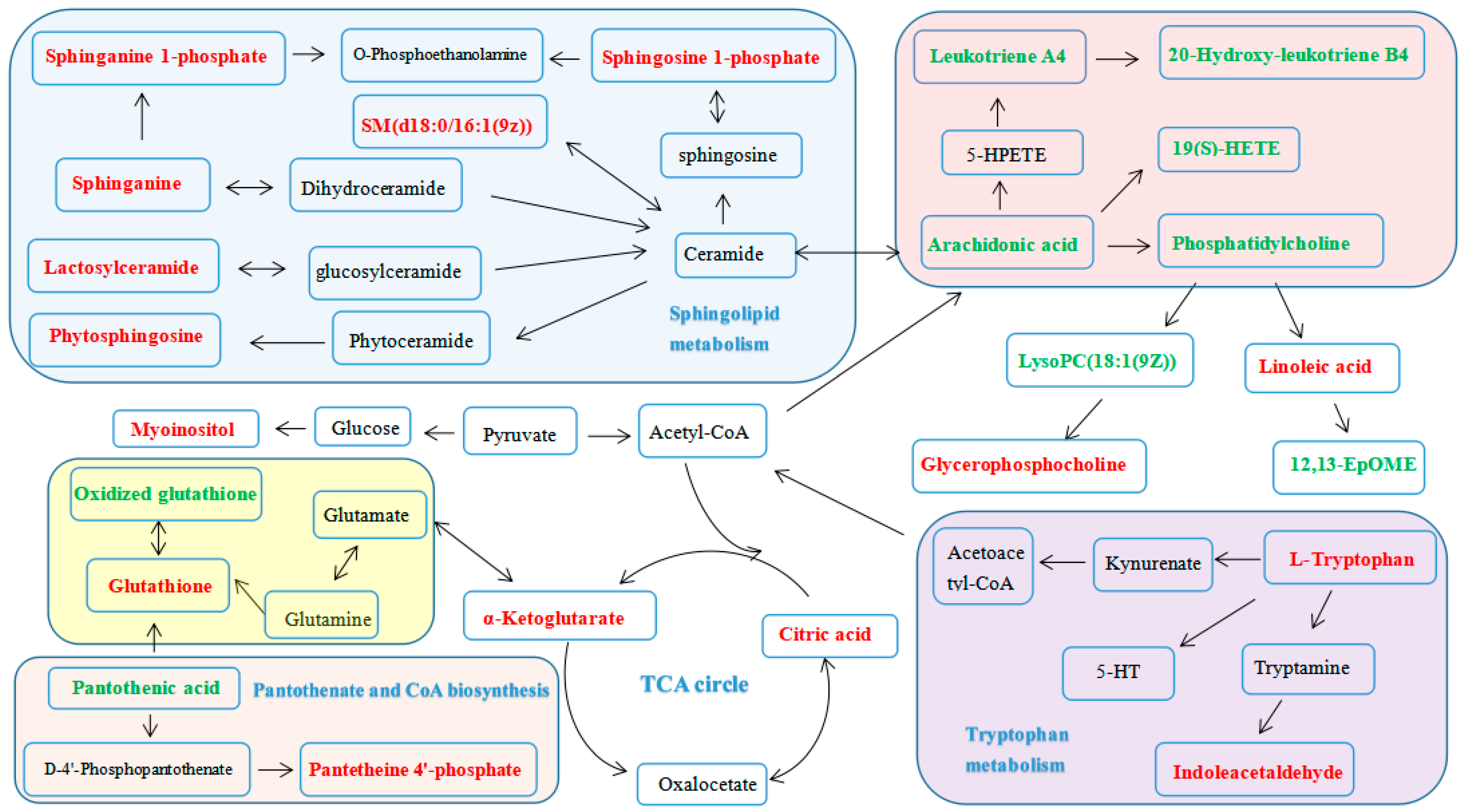
| No. | tR/min | Measured Mass (Da) | VIP | Formula | Mass Error (ppm) | Adducts | Biomarkers | HMDB ID | Pathway | Content Level | Source and Mode |
|---|---|---|---|---|---|---|---|---|---|---|---|
| 1 * | 0.58 | 280.0929 | 2.17 | C8H20NO6P | 1.07 | M + Na | Glycerophosphocholine | HMDB00086 | Gly M | CM < CD | Serum-ESI+ |
| 2 * | 0.60 | 203.0528 | 2.56 | C6H12O6 | 0.03 | M + Na | Myoinositol | HMDB00211 | IM | CM < CD | Serum-ESI+ |
| 3 * | 0.67 | 169.0117 | 1.23 | C5H6O5 | 2.37 | M + Na | α-Ketoglutarate | HMDB00208 | TCA cycle | CM < CD | Serum-ESI+ |
| 4 * | 0.72 | 306.0746 | 5.14 | C10H17N3O6S | −4.57 | M − H | Glutathione | HMDB00125 | Glu M | CM < CD | Hip-ESI− |
| 5 * | 0.74 | 215.017 | 1.15 | C6H8O7 | 0.93 | M + Na | Citric acid | HMDB00094 | TCA cycle | CM < CD | Serum-ESI+ |
| 6 * | 0.78 | 611.144 | 2.45 | C20H32N6O12S2 | −0.16 | M − H | Oxidized glutathione | HMDB03337 | Glu M | CM > CD | Hip-ESI− |
| 7 a | 0.85 | 357.0904 | 2.26 | C11H23N2O7PS | 5.32 | M − H | Pantetheine 4′-phosphate | HMDB01416 | PCB | CM < CD | Hip-ESI− |
| 8 * | 0.9 | 218.1015 | 2.03 | C9H17NO5 | −5.96 | M − H | Pantothenic acid | HMDB62717 | PCB | CM > CD | Hip-ESI− |
| 9 * | 1.46 | 203.0816 | 1.33 | C11H12N2O2 | −2.46 | M − H | L-Tryptophan | HMDB00929 | TM | CM < CD | Serum-ESI− |
| 10 a | 5.16 | 204.0651 | 1.45 | C10H9NO | −4.90 | M + FA − H | Indoleacetaldehyde | HMDB01190 | TM | CM < CD | Serum-ESI− |
| 11 * | 13.00 | 318.3011 | 3.61 | C18H39NO3 | 0.94 | M + H | Phytosphingosine | HMDB04610 | SM | CM < CD | Serum-ESI+ |
| 12 * | 15.33 | 302.3054 | 1.82 | C18H39NO2 | −1.65 | M + H | Sphinganine | HMDB00269 | SM | CM < CD | Serum-ESI+ |
| 13 * | 15.43 | 378.2399 | 2.21 | C18H38NO5P | −2.64 | M − H | Sphingosine 1-phosphate | HMDB00277 | SM | CM < CD | Serum-ESI− |
| 14 a | 15.98 | 380.2556 | 1.4 | C18H40NO5P | −2.63 | M − H | Sphinganine 1-phosphate | HMDB01383 | SM | CM < CD | Serum-ESI− |
| 15 a | 16.79 | 341.2102 | 1.23 | C20H30O3 | 2.64 | M + Na | Leukotriene A4 | HMDB01337 | AM | CM > CD | Serum-ESI+ |
| 16.79 | 317.212 | 5.94 | C20H30O3 | 0.95 | M − H | Leukotriene A4 | HMDB01337 | AM | CM > CD | Serum-ESI− | |
| 16 * | 17.18 | 295.2265 | 1.24 | C18H32O3 | −2.71 | M − H | 12,13-EpOME | HMDB04702 | LM | CM > CD | Serum-ESI− |
| 17 * | 18.14 | 319.2272 | 11.62 | C20H32O3 | −0.31 | M − H | 19(S)-HETE | HMDB11136 | AM | CM > CD | Serum-ESI− |
| 1.68 | Hip-ESI− | ||||||||||
| 18.14 | 343.224 | 2.67 | C20H32O3 | −2.62 | M + Na | 19(S)-HETE | HMDB11136 | AM | CM > CD | Serum-ESI+ | |
| 18 a | 18.55 | 522.3565 | 5.75 | C26H52NO7P | 0.96 | M + H | LysoPC (18:1(9Z)) | HMDB02815 | Gly M | CM > CD | Serum-ESI+ |
| 8.05 | Hip-ESI+ | ||||||||||
| 18.49 | 566.3466 | 4.92 | C26H52NO7P | 1.41 | M + FA − H | LysoPC(18:1(9Z)) | HMDB02815 | Gly M | CM > CD | Serum-ESI− | |
| 4.99 | Hip-ESI− | ||||||||||
| 19 a | 22.75 | 782.5717 | 1.61 | C44H80NO8P | 2.17 | M + H | 18:1/18:3 phosphatidylcholine | HMDB08107 | AM, Gly M | CM > CD | Hip-ESI+ |
| 20 * | 22.81 | 303.2330 | 4.88 | C20H32O2 | 1.98 | M − H | Arachidonic acid | HMDB01043 | AM | CM > CD | Serum-ESI− |
| 2.87 | Hip-ESI− | ||||||||||
| 21 * | 23.14 | 279.2321 | 4.18 | C18H32O2 | −1.07 | M − H | Linoleic acid | HMDB00673 | LM | CM < CD | Serum-ESI− |
| 22 * | 23.26 | 397.2243 | 1.1 | C20H32O5 | 4.28 | M + FA − H | 20-Hydroxy-leukotriene B4 | HMDB01381 | AM | CM > CD | Serum-ESI− |
| 23 a | 25.4 | 828.5760 | 1.49 | C44H82NO8P | 0.60 | M + FA − H | 18:1/18:2 phosphatidylcholine | HMDB08137 | AM, LM, Gly M | CM > CD | Serum-ESI− |
| 24 a | 25.91 | 826.5605 | 2.38 | C44H80NO8P | 0.85 | M + FA − H | 18:3/18:1 phosphatidylcholine | HMDB08203 | AM, Gly M | CM > CD | Hip-ESI− |
| 25 * | 26.11 | 806.5628 | 1.39 | C42H79NO13 | −0.25 | M + H | Lactosylceramide | HMDB04866 | SM | CM < CD | Serum-ESI+ |
| 26 a | 26.38 | 824.5463 | 2.20 | C44H78NO8P | 2.55 | M + FA − H | 18:2/18:3 phosphatidylcholine | HMDB08141 | AM, Gly M | CM > CD | Hip-ESI− |
| 27 a | 26.93 | 747.5648 | 2.91 | C39H79N2O6P | −0.54 | M + FA − H | SM (d18:0/16:1) | HMDB13464 | SM | CM < CD | Serum-ESI− |
| 28 a | 27.13 | 782.5672 | 3.34 | C42H82NO8P | −0.51 | M + Na | 16:0/18:1 phosphatidylcholine | HMDB07972 | AM, LM, Gly M | CM > CD | Serum-ESI+ |
| 27.20 | 804.577 | 1.79 | C42H82NO8P | 1.86 | M + FA − H | 16:0/18:1 phosphatidylcholine | HMDB07972 | AM, LM, Gly M | CM > CD | Hip-ESI− | |
| 29 a | 28.61 | 828.5736 | 1.53 | C44H82NO8P | −2.29 | M + FA − H | 18:2/18:1 phosphatidylcholine | HMDB08105 | AM, LM, Gly M | CM > CD | Serum-ESI− |
| Compound No. | M & N | M & HPF | ||
|---|---|---|---|---|
| AUC | p | AUC | p | |
| 1 | 1.000 | 0.001 | 1.000 | 0.001 |
| 2 | 1.000 | 0.001 | 0.891 | 0.009 |
| 3 | 0.859 | 0.016 | 1.000 | 0.001 |
| 4 | 1.000 | 0.001 | 1.000 | 0.001 |
| 5 | 1.000 | 0.001 | 1.000 | 0.001 |
| 6 | 0.984 | 0.001 | 0.984 | 0.001 |
| 7 | 0.969 | 0.002 | 0.859 | 0.016 |
| 8 | 0.922 | 0.005 | 0.984 | 0.001 |
| 9 | 1.000 | 0.001 | 1.000 | 0.001 |
| 10 | 1.000 | 0.001 | 1.000 | 0.001 |
| 11 | 1.000 | 0.001 | 1.000 | 0.001 |
| 12 | 1.000 | 0.001 | 1.000 | 0.001 |
| 13 | 1.000 | 0.001 | 1.000 | 0.001 |
| 14 | 1.000 | 0.001 | 1.000 | 0.001 |
| 15 | 1.000 | 0.001 | 1.000 | 0.001 |
| 16 | 1.000 | 0.001 | 1.000 | 0.001 |
| 17 | 1.000 | 0.001 | 1.000 | 0.001 |
| 18 | 1.000 | 0.001 | 1.000 | 0.001 |
| 19 | 1.000 | 0.001 | 1.000 | 0.001 |
| 20 | 1.000 | 0.001 | 1.000 | 0.001 |
| 21 | 1.000 | 0.001 | 1.000 | 0.001 |
| 22 | 1.000 | 0.001 | 1.000 | 0.001 |
| 23 | 1.000 | 0.001 | 1.000 | 0.001 |
| 24 | 0.930 | 0.004 | 0.898 | 0.007 |
| 25 | 1.000 | 0.001 | 1.000 | 0.001 |
| 26 | 1.000 | 0.001 | 1.000 | 0.001 |
| 27 | 1.000 | 0.001 | 1.000 | 0.001 |
| 28 | 1.000 | 0.001 | 1.000 | 0.001 |
| 29 | 1.000 | 0.001 | 1.000 | 0.001 |
| Pathway Name | Match Status | p | −log (p) | Holm p | FDR | Impact |
|---|---|---|---|---|---|---|
| Sphingolipid metabolism | 6/21 | 1.1904 × 10−6 | 13.6410 | 9.7613 × 10−5 | 9.7613 × 10−5 | 0.1955 |
| Linoleic acid metabolism | 3/6 | 1.1897 × 10−4 | 9.0367 | 0.0096 | 0.0045 | 1.0 |
| Rachidonic acid metabolism | 5/36 | 4.2879 × 10−4 | 7.7545 | 0.0339 | 0.0088 | 0.5012 |
| Glycerophospholipid metabolism | 3/30 | 0.0178 | 4.0294 | 1.0 | 0.2917 | 0.2065 |
| TCA cycle | 2/20 | 0.0539 | 2.9224 | 1.0 | 0.7353 | 0.1216 |
| Glutathione metabolism | 2/26 | 0.0858 | 2.4552 | 1.0 | 0.9413 | 0.3979 |
| Tryptophan metabolism | 2/40 | 0.1755 | 1.7402 | 1.0 | 1.0 | 0.1954 |
| Pantothenate and CoA biosynthesis | 2/15 | 0.0315 | 3.4571 | 1.0 | 0.5169 | 0.3265 |
| Inositol phosphate metabolism | 1/28 | 0.4195 | 0.8686 | 1.0 | 1.0 | 0.1116 |
© 2019 by the authors. Licensee MDPI, Basel, Switzerland. This article is an open access article distributed under the terms and conditions of the Creative Commons Attribution (CC BY) license (http://creativecommons.org/licenses/by/4.0/).
Share and Cite
Wang, C.; Lin, H.; Yang, N.; Wang, H.; Zhao, Y.; Li, P.; Liu, J.; Wang, F. Effects of Platycodins Folium on Depression in Mice Based on a UPLC-Q/TOF-MS Serum Assay and Hippocampus Metabolomics. Molecules 2019, 24, 1712. https://doi.org/10.3390/molecules24091712
Wang C, Lin H, Yang N, Wang H, Zhao Y, Li P, Liu J, Wang F. Effects of Platycodins Folium on Depression in Mice Based on a UPLC-Q/TOF-MS Serum Assay and Hippocampus Metabolomics. Molecules. 2019; 24(9):1712. https://doi.org/10.3390/molecules24091712
Chicago/Turabian StyleWang, Cuizhu, Hongqiang Lin, Na Yang, Han Wang, Yan Zhao, Pingya Li, Jinping Liu, and Fang Wang. 2019. "Effects of Platycodins Folium on Depression in Mice Based on a UPLC-Q/TOF-MS Serum Assay and Hippocampus Metabolomics" Molecules 24, no. 9: 1712. https://doi.org/10.3390/molecules24091712
APA StyleWang, C., Lin, H., Yang, N., Wang, H., Zhao, Y., Li, P., Liu, J., & Wang, F. (2019). Effects of Platycodins Folium on Depression in Mice Based on a UPLC-Q/TOF-MS Serum Assay and Hippocampus Metabolomics. Molecules, 24(9), 1712. https://doi.org/10.3390/molecules24091712





